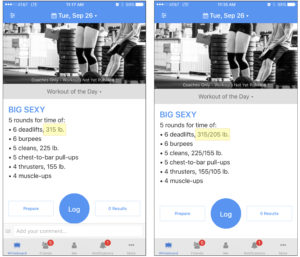Imagine it’s a warm Sunday afternoon, and I came over to your house to watch a baseball game. Midway into the first inning, the Rockies make two outs, and I say to you, “Two outs! That’s the end of the inning.” Confused, you look at me and state, “No, there are three outs per inning.” Over the next five minutes, I explain why there are two outs in an inning and give examples such as, “Well, that’s how my Little League played baseball.”
Believing that there are two outs in an inning of baseball is like believing that the women’s weight for Fran is 55, opposed to 65.
The CrossFit world has engrained particular male and female weight pairings into its culture – 95/65, 135/95, 155/105 – and the loading relationship remains the same independent of the workout.
The mainsite lists one loading for each workout which is commonly understood to be the men’s weight. This is the source of the confusion about what is the exact women’s weight because the women’s weights are not listed. Each week at SugarWOD HQ, we get emails saying that our Library of workouts has the women’s weights listed incorrectly.
There are many theories as to why the women’s weights are not listed, and the most compelling I’ve heard is that Coach Glassman did not want to exclude the possibility that women could do the same, or similar, weights as men. If each workout is designed with a specific intended stimulus and time domain (intensity), then simply having one loading for the top athlete is enough. Each individual should scale accordingly based on their capacity, the intent of the workout, and with the goal of completing the work in a similar time domain as the top athlete.
And right there is where we get at the heart of the issue. The goal of any workout is to achieve the intended stimulus. Listing the women’s weights for the workout helps enable this by bringing consistency and clarity to the process while also driving a comparable training platform across genders.
Every workout is designed to create a particular stimulus in the athlete, and everyone should always scale for whatever reason necessary. Adding the women’s weights to the workout brings an additional data point to help triangulate athletes into a loading that gets at the intended stimulus.
So the million dollar question remains, What’s the women’s weight?!
Today, we’re going to settle that. Maybe not for all of CrossFit, that sounds ambitious, but within the workout tracking world of SugarWOD, we are going to explain why the women’s weights listed in our Library of Girls, Heroes, and other standard CrossFit benchmarks are what they are. Along the way, we’ll provide insight and historical information to explain why we’re going with the numbers we are.
What’s the Women’s Weight?
When asking “what’s the women’s weight?” for any given workout, I’ve heard it all:
- 65%
- 67.5%
- 70%
To be clear, that is 65, 67.5, or 70% of the listed men’s weight for the workout. As an example, if the men’s weight is 95, we take 67.5% of 95 to arrive at the women’s weight.
Honestly, it doesn’t really matter what exact percentage we use – what is important is that it is consistent and that it’s entered somewhere so people can compare over time. Consistency matters. You can’t prescribe Isabel with 135/95 and then prescribe another workout with snatches where the men’s weight is 135, and the women’s weight is 85. The relationship must be kept consistent.
History Lane
To understand the background on loading, let’s take a walk down memory lane.
It may be hard to believe, but in the early days of CrossFit, there were no women’s bars gracing the floors of CrossFit affiliates everywhere. There were PVC pipes and 45lb bars. While it surprised many at the 2013 Regionals to see that CrossFit prescribed the workout Jackie for men AND women at 45lbs, I’m guessing that the original Jackie was also 45lbs for both males and females. More on why this is relevant in a moment!
Let’s get to the original barbell relationship, and that is 95 and 65. A match made in heaven, an intensity tornado, two numbers near and dear to every CrossFitters’ heart. This original loading pairing comes out to 67.5% and lays the foundation for calculating the women’s weights. The 135/95 pairing is an extension of this original relationship and we can find it applied to many of other CrossFit loading relationships.
That being said, we will often hear from affiliates that the women’s weight for Grace is 85 pounds. Perhaps this is because the bar still has 2 25lb plates gracing (haha) each side of the barbell; however, in the early days, those 2 25s would have been put on a 45-pound barbell to make for 95 pounds.
Our Stance
At SugarWOD, we like data, and we like comparing past performances. We realized that by not entering the women’s weights into workouts paired with inconsistent numbers on “what’s the women’s weights” throughout the community, that we were inhibiting the comparison of past performances as well as accurate data collection. Did I mention that we like data?

Going forward, SugarWOD will specify both Men’s and Women’s weights in our library of workouts. If CrossFit.com didn’t originally specify both weights, then we’re going to use the following rationale and chart listed below.
We could even conjure up a scenario (or maybe this happened at Roots, to me!, and is the impetus for this post!) where a workout was prescribed with 185-pound front squats for men. The coach for the day listed the women’s weight at 125. I did the workout, recorded in my SugarWOD notes information about my pacing, sets, and how they felt, but I did not list the weight I used for the workout. Afterall, I did it RX so simply checking the RX box should be enough, right? Wrong! Six months we repeated this workout at CrossFit Roots. The coach for the day listed the women’s weight for the same workout at 135. I did the workout and was supremely disappointed to find out that my score was slower than last time – but I did it with 10 pounds more! A little bit of investigating proved that the first time we had done the workout, it was prescribed at 125 for women and the second time at 135.
The point is that a consistent approach across all loadings for “what’s the women’s weight” is necessary.
The Men’s and Women’s Loading Chart
Going forward, SugarWOD will specify both Men’s and Women’s weights in our Library of workouts. If CrossFit.com didn’t originally specify both weights, then we’re going to use the following rationale and chart.

You can view the full table, with the exact 67.5% loading for each men’s weight, by clicking HERE.
For fun, we’ve included some background notes on why we made certain decisions for loading when they didn’t exactly come out to 67.5%. We chose 67.5% as this is the percentage of the 95/65 relationship and we know that this relationship produces the same potential for intended stimulus between men and women. In other words, this relationship enables both men and women to produce times at the 2:00-minute mark for Fran.
Remember, you can always change a weight, just make sure you’re not shortchanging your female athletes!